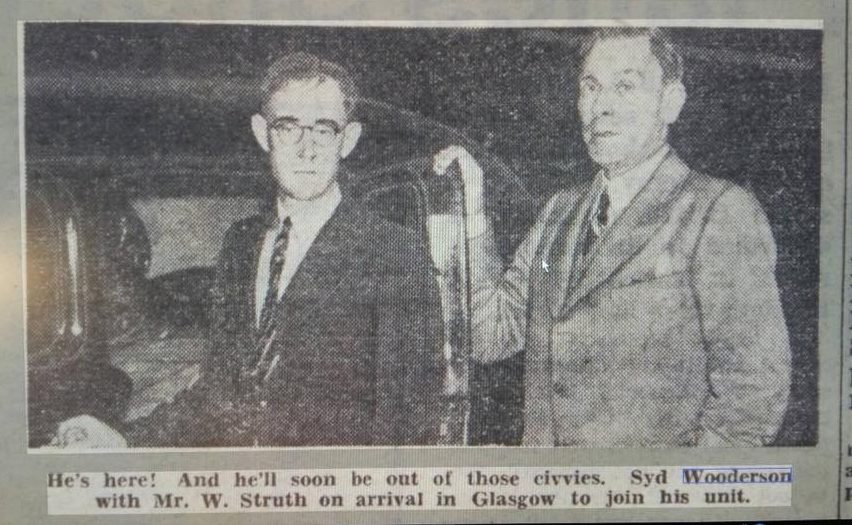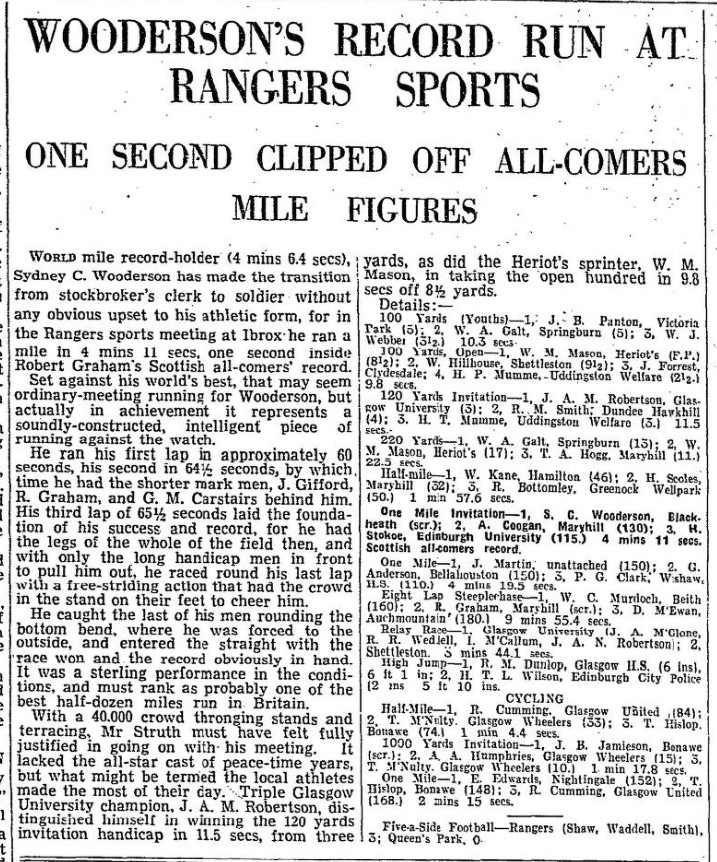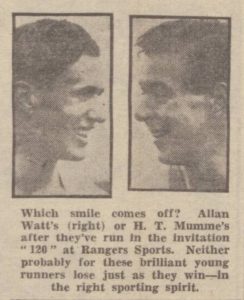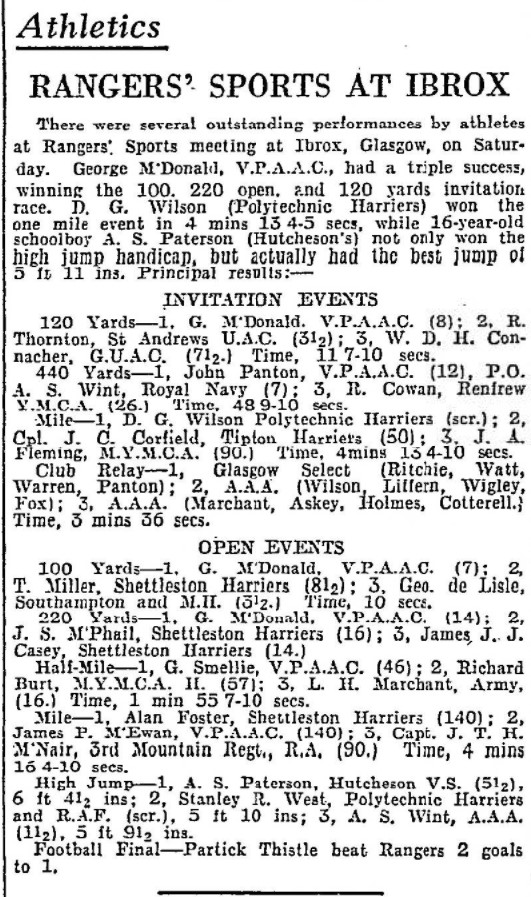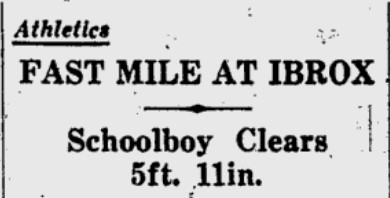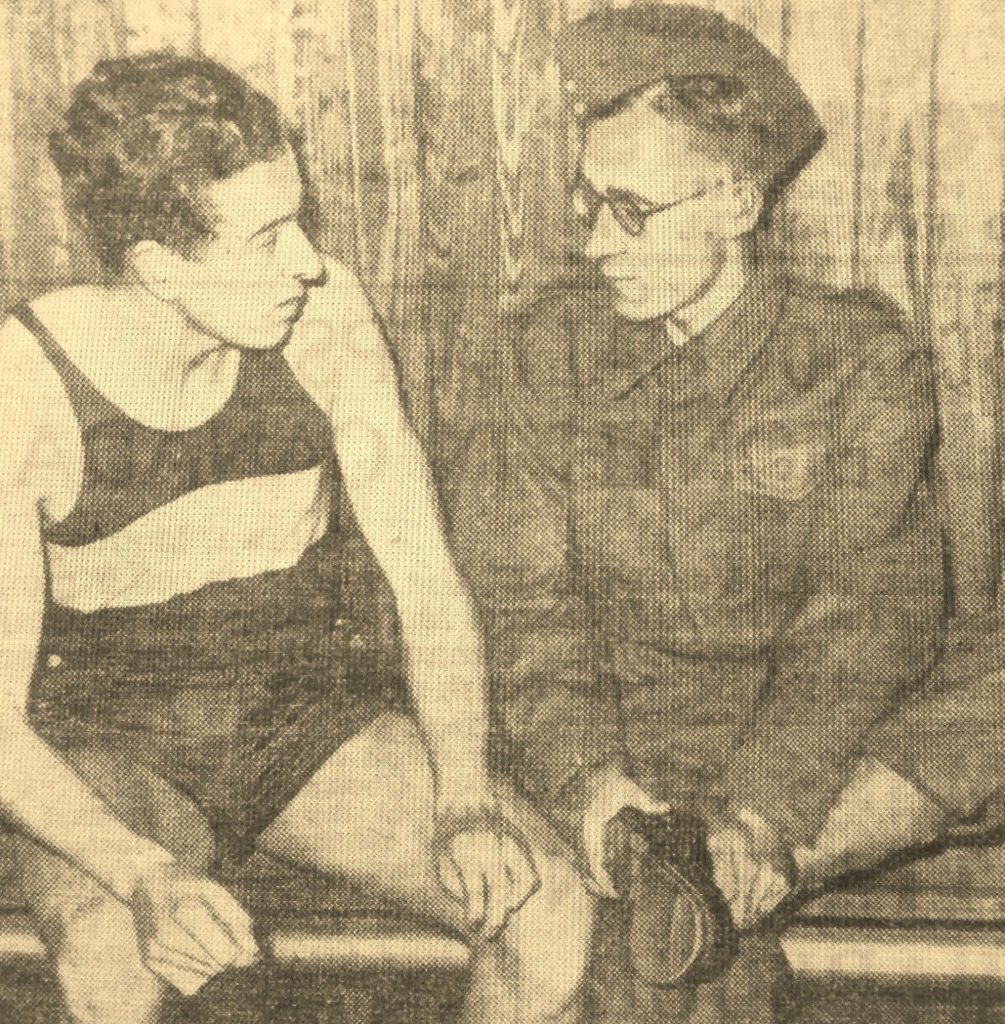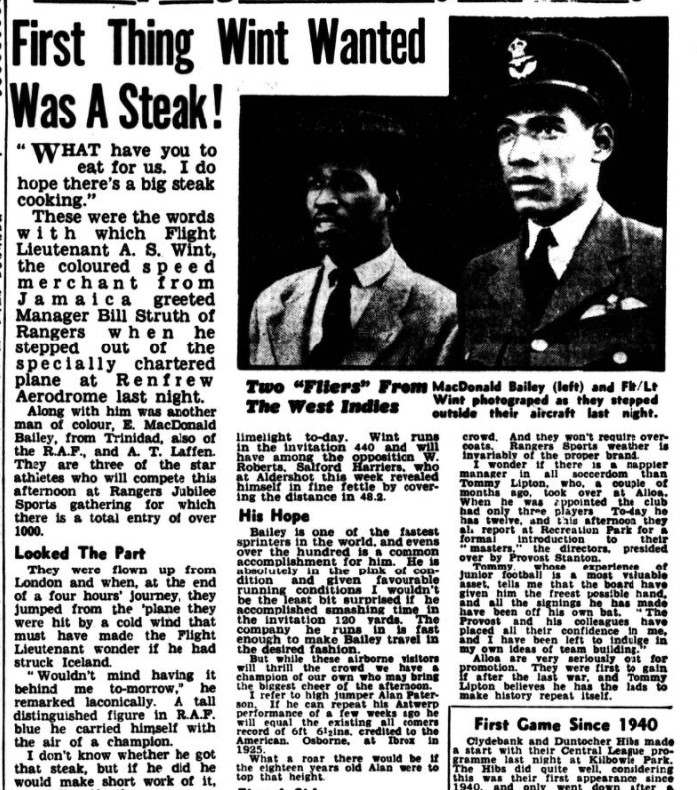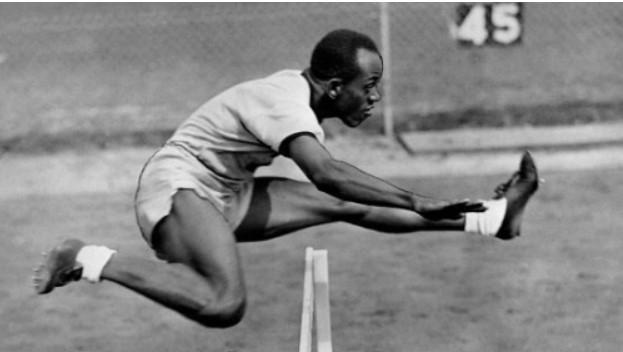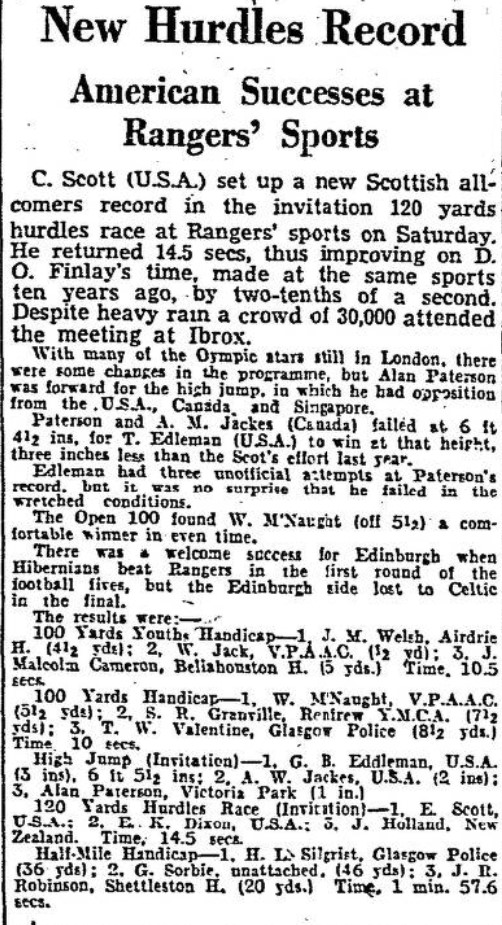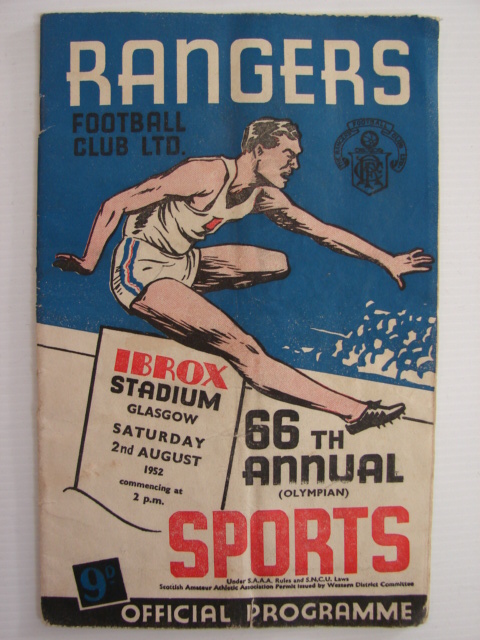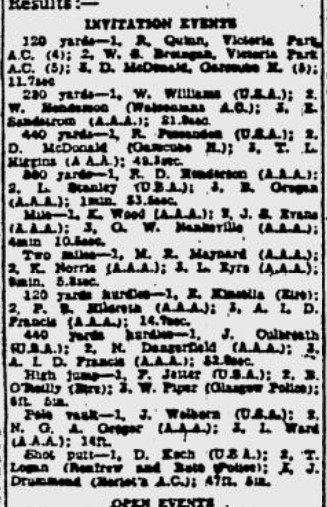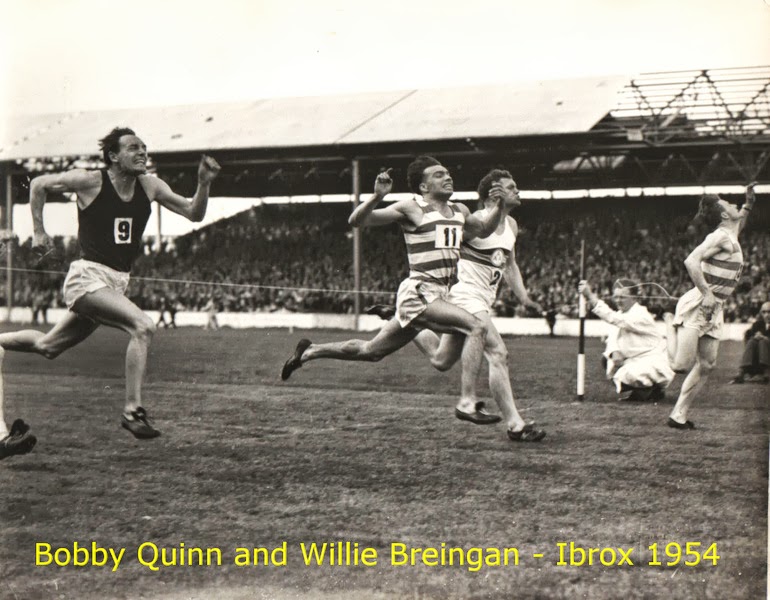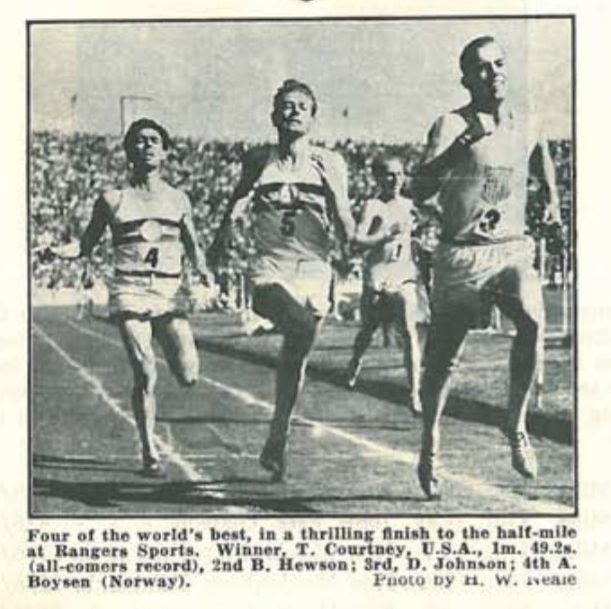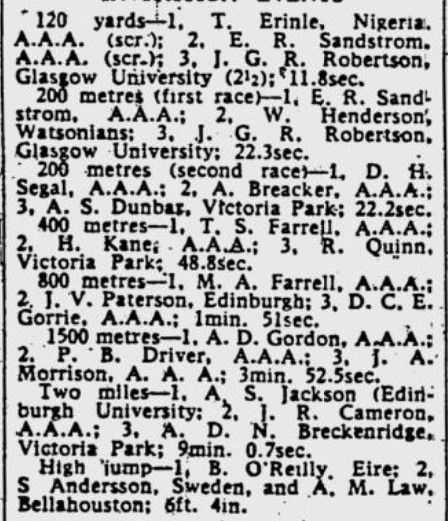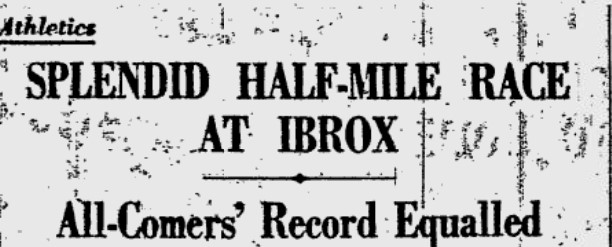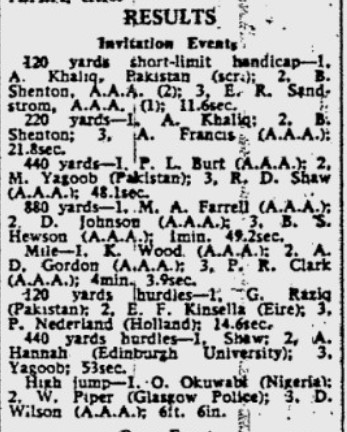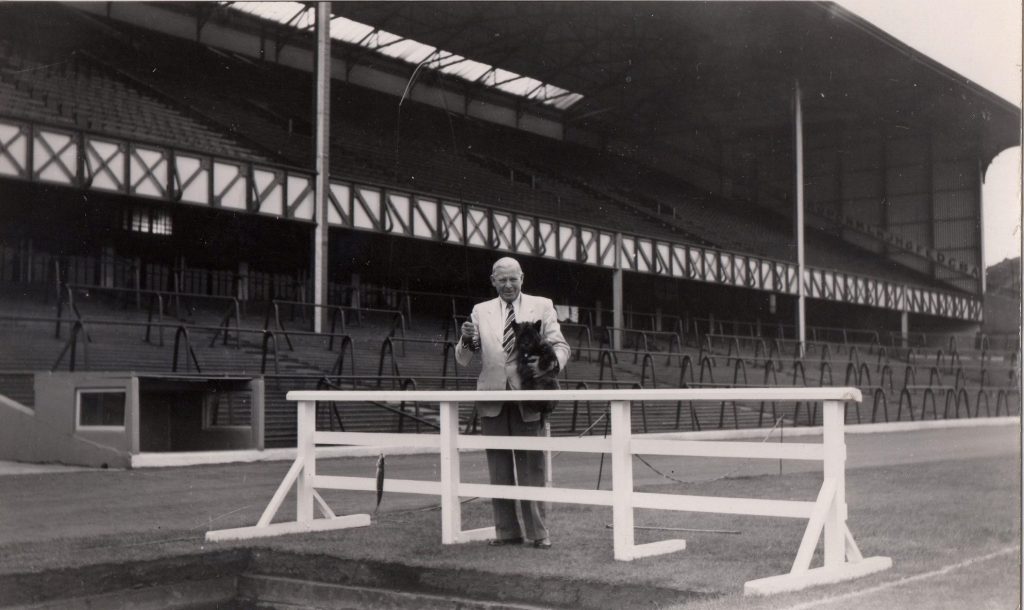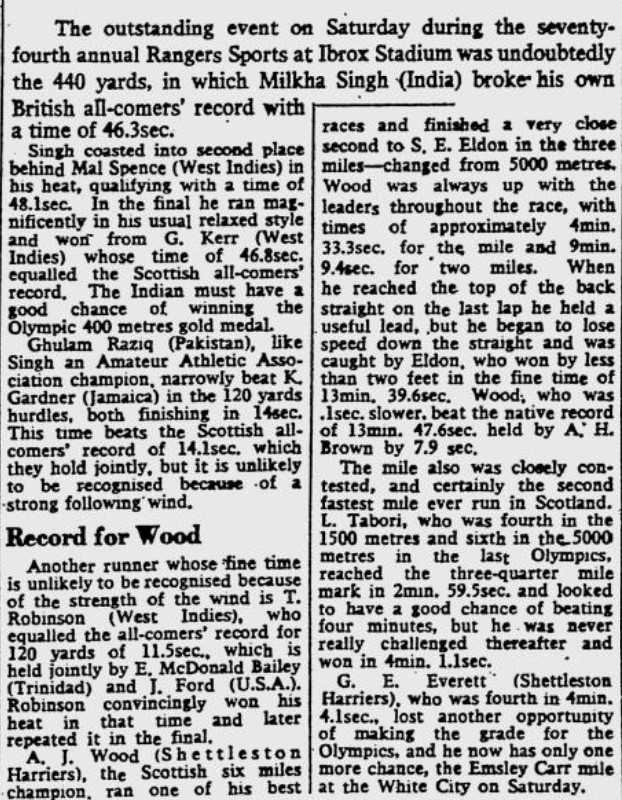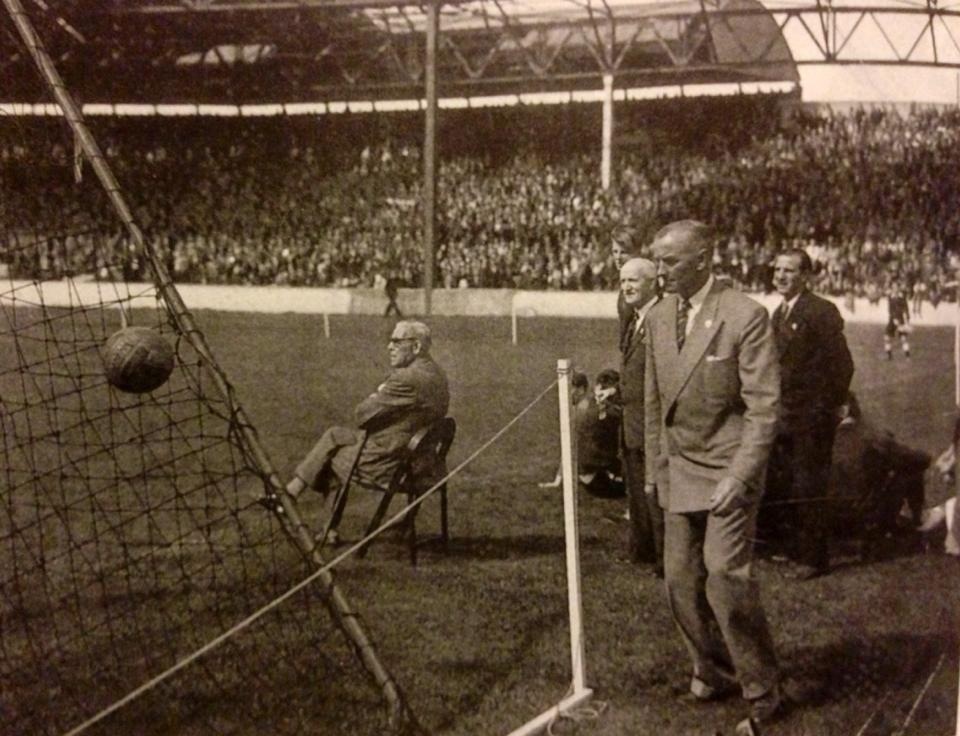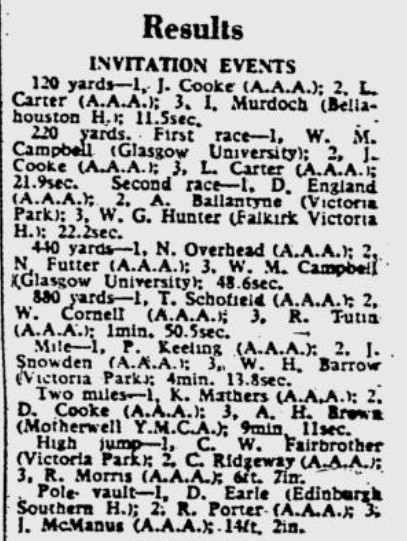Wooderson was always a favourite in Glasgow
1940 was an important year in that Maley retired, and with no Celtic Sports the Rangers Sports were undisputedly the biggest in the country and Struth was the man responsible for the continuation and organisation of them. It was also a much more important year for everyone in that it was the first year of the Second World War which imposed constraints on all walks of life. There were only seven years between their dates of birth Maley 1868, Struth 1875) and Maley had run the sports at Celtic Park for the best part of 50 years with a hiatus for a World War, while Struth would go on to be in charge for 42 years, also with a World War with which to contend.
THE WAR YEARS
There were sports in 1940 but it was a vastly different world from 1915, a vastly different war and for civilians some things went on with a degree of normality. Would there be sports in 1940? There certainly would.
A 40,000 crowd, top talent in the invitation mile, and the best of local talent. And the mile produced an all-comers record. The 120 yards also upset the Daily Record’s prediction – note the photograph below.
Bill Struth was mentioned in the text and had his photograph welcoming Wooderson to Glasgow to join his unit. What more could we want? We could want more in 1941 and we had it. The Sports that year had both Watt and Mumme – Watt won the 129 yards off a yard and a half and Mumme was unplaced in the 100 yards final where he was ‘handicapped out of it. Wooderson was unavailable but there was an international dimension when a Canadian serviceman won the half-mile. There had been a crowd of 40,000 and approximately 600 competitors.
The Glasgow Herald tells us that Wooderson was back at Ibrox for the Sports in 1943 before a crowd of 35,000 and there were no records this time – it is a measure both of his talent and esteem in which he was held by Glaswegians that one was hoped for. Conceding starts of up to 145 yards, he did catch his English rival DG Wilson who would go on to great things but was nowhere near the front men in the handicap. It was another competitive meeting but there were no records and no stars but the club must be given credit for putting the meeting on.
With newsprint at a premium, coverage was slight at the best of times but the sports in 1944 were of a high standard. The complete report from The Scotsman is below.
The Scotsman gave maximum coverage to the English miler, who did run well, but the buzz was all about the high jumper from Hutcheson’s. Note the headline from the Glasgow Herald:
The Sports of 1945 were held on 4th August with an estimated 40,000 spectators present, and the papers – whether the Daily Record, the Glasgow Herald or the Scotsman – all homed in on three events. These were the high jump (Boy Clears 6’3″), the quarter mile, and the 100 yards. In the High Jump Paterson was jumping from scratch while the AAA’s champion had an allowance of 1″. Paterson cleared 6 feet 3 inches while the best the Englishman could do with the 1″ added was 5’9″. In the 440 yards invitation, the Victoria Park runner John Panton won from Denroche of the AAA’s and Arthur Warton of Garscube in 49.6 seconds, and in the 100 yards Cyril Holmes ran an unofficial time of 11.5 seconds.
The War was now over and Mr Struth’s Committee had had ‘a good war’ in that
(a) there had been sports every year
(b) they were always before good crowds with 35,000 – 40,000 spectators being the usual;
(c) they were always of a good standard with class athletes in the invitation events and large numbers in the open ones. In the photograph below we see Sydney Wooderson in uniform talking with Allan Watt of Shettleston Harriers;
(d) there were even records set at some of them.
AFTER THE WAR
The first peace time Games were a tremendous success with Alan Paterson setting a new Scottish record of 6 feet 6 1/2 inches to break the existing record set by the American Osborne at the same ground in 1925. There were huge fields for the open events and a good following wind which helped the sprinters. For instance, MacDonald Bailey in the 120 yards was beaten in his heat but ran a time of 11.5 seconds – 5 yards inside even time. His conqueror by a matter of inches was Whigham of VPAAC running off eight and a half yards. Artrhur Wint, the tall Jamaican, was third in the 440 yards invitation where, running from scratch, he was beaten by two men with handicaps of 16 yards and 10 yards. Struth had done it again and he was mentioned by name in the Daily Record preview on the Saturday morning: note this extract from a very long article
A hard act to follow and the prospect led to a record crowd of 72,000 (seventy two thousand) paid the entrance money and once again Alan Paterson was the local hero. There was a terrific high jump competition with Bill Vessie (USA) in which they both broke the British high jump recordwhen they cleared 6′ 7 1/2″ – everybody else was out at 6′ but they battled it out on their own with the crowd enthralled by the head-to-head. Vessie won but only because he cleared the height first time while Paterson had one failure. There were stars aplenty in 1947.
- MacDonald Bailey won the 100 yards in 10.4 seconds
- Harrison Dillard (USA, pictured below) beat Don Finlay (GB) by two yards in the 110 yards hurdles in 14.9 seconds
- EQ Cofie (EUAC) defeated Walter Smith (USA) in the 440 yards
- T Perkins (USA) defeated Bill Nankeville (GB in the 880 yards;
- Curtis Stone (USA) won the eight laps steeplechase by 100 yards from AA Robertson (AAA’s champion)
- USA won the Mile medley relay from the AAA’s A tema dn AAA’s B team with Scotland fourth;
- R Richards won the pole vault with a height of 13′ 6″
All the open events were very well supported and the programme took 4 hours to get through.
1948 was another good year but the heavy rain on the day had a drastic effect on the crowd size and, more importantly, on the standard of performances – eg Alan Paterson could ‘only’ clear 6’4″ despite having opposition from Canada, USA and Singapore. It was of course Olympic year and most of the top names that Struth might have wanted were still in London. The report in trhe Scotsman was fairly short.
Despite the presence of English and American Olympians competing the best performance of the day was from an Irishman in the invitation 2 miles race where JJ Barry, from Clonliffe, won from Andy Forbes (VPAAC) and J Reid (West Kilbride AAC). Barry was living and running in Scotland at the time and ran in the colours of the St Machan’s club. Other notable victories was Don Finlay winning the sprint hurdles from Dick Attlesey (USA), Brown (USA) beating DK Gracie (Scotland) in the 440 yards hurdles and Alan Paterson (“only doing what he needed to to win”) in the high jump from Richard Phillips (USA) and Mondschein (USA) with a best jump of 6′ 4″. Irving Mondscheing was also second in the shot putt behind J Drummond of Heriot’s. Even on a wet and miserable day, Struth had managed a programme that brought tens of thousands into the ground. He always had something to bring in the crowd – Willie Waddell was playing in the five-a-sides but his actual registration as a professional Rangers player back in 1939 had been delayed by the manager/promoter. Why was that?
“Early in his Army career when he (Allan Watt) was stationed in Orkney, he was given three days leave to travel to Glasgow to compete in the Rangers Sports. A summons had come from Bill Struth, the legendary Rangers manager, asking the army to give Allan time off to take part in the invitation 100 yards against the American Clyde Jeffrey. Fifty years later Allan was to learn that Mr Struth had another reason for wanting him to appear. The American was the scratch man. Allan was off one and a half yards and Willie Waddell, the famous footballing Deedle Dawdle of Rangers, was off three yards. The Yank won, Allan was second and ‘Deedle’ third. In the early 1990’s Allan was at Ibrox as a guest of Rangers at Ibrox when the wife of the Rangers doctor recalled the wartime race. She claimed that Struth had deliberately kept Deedle an amateur so that he could take part and the crowd would see a Rangers player beat the American guest and the Scottish star. The Deedle turned professional immediately after the race.”
It was wet again in 1950 but there were 35,000 spectators inside Ibrox to see three records broken – Mal Whitfield, the 26 year old Olympic champion from America won the half mile in 1:50.7, Arthur Wint won the 440 yards beating USA’s R Pearman in 47.7, MacDonald Baily won the 120 yards in 11.3 which was a British record while the former two were Scottish all-comers records. The otheer invitation event victors were
- 110 yards hurdles: W Fleming USA 15 seconds
- 220 yards: Arthur Bragg (USA) 21.5 seconds
- 2 Miles: H Ashenfelter (USA) 9:15.6
- High Jump: AS Paterson 6′ 4″
- One Mile DG Wilson 4 min 17.3 secs.
The Americans were now becoming a regular feature at Ibrox and Olympic year of 1952 was probably the best ever collection of athletes who were taking part in the Rangers Sports at the same time. The Olympics were held between 19th July and 3rd August; the Sports were held on the 2nd August. The result of that was
- 5 Olympic champions: Lindy Remigino, 100 metres, George Rhoden, 400 metres, Walt Davis, high jump, S Iness, Discus, R Mathias, decathlon;.
- 2 winning Olympic relay teams, with only minor modifications eg the Jamaican 4 x 400 team substituted L Beach for Laing
- 4 Olympic silver medallists, Herb McKenley, Arthur Wint, Don Laz, D Hooper
- Many of the GB team from the Olympics, eg Bill Nankeville, Geoff Elliott, J Savidge, Brian Shenton, MacDonald Bailey
- Local heroes who were in the GB team – Bill Jack (VPAAC), Alan Paterson (VPAAC) and David Gracie (GUAC)
- The weather was good, the crowd was over 50,000, and there were several British and Scottish records set in the course of the afternoon
It was a wonderful year all round for Scottish athletics – many of the Olympians were taking part in one, two or even three events in the country that year. On the last Saturday in June, before the Games, there were many intending competitors at the Glasgow Police Sports, then just one day before the Games ended there were man who by now were medalists, at the Rangers Sports and two weeks after that there was the Edinburgh Highland Games. Some athletes even waited a further week and took part in the Cowal Highland Games at Dunoon. The three Games are covered at this link . Of the three, Rangers Sports probably had the athletes at their best, immediately after the Games, by Edinburgh they were starting to get tired and several of the athletes had gone home, but the Australian and New Zealand women who had not been at Ibrox were there. The promoters in August were two big men who knew how to promote a meeting – Struth at Ibrox and Carmichael at Murrayfield. It is impossible to doubt that they were in contact with each other – remember that Maley had taken his international guests to Loch Lomond for the weekend between the two Celtic Games (Saturday and Tuesday). There were three weeks between the meetings and the athletes had other meetings to attend. One wonders why they came back all the way to Scotland but come back they did. One week took care of itself – the Saturday after Ibrox saw many of the athletes at the White City in London, some even added a meeting at Berlin on the Sunday. Ibrox, White City and Berlin in 9 days. Then came Edinburgh It had been a superlative year of athletics.
1953 was inevitably a bit of a comedown for the Sports – in reply to the shout of “Follow that!” would come the reply “How?” Well, there was a decent selection of runners from outwith Scotland:
- from the USA came the winners of the 220 yards, 880 yards, pole vault and half mile;
- from Ireland came the winner in the high jump and
- the long jump was won by a Nigerian.
- In addition there was a strong team from the AAA’s whose representatives took part in the open events as well as the invitation events.
- The two races highlighted were the short limit invitation 2 miles where Ian Binnie took AAA’s Len Eyre through the mile in 4:26, with the limit man, John Stevenson of Greenock Wellpark well clear. On the last lap, Eyre passed Binnie but couldn’t get on terms with Stevenson who won and took home a canteen of cutlery as a reward for his efforts. Stevenson was a Scottish international runner and it would seem that 150 yards was a biggish start. The other race highlighted was the 440 yards hurdles where the American D Bright went off swiftly and fell at the 7th hurlde leaving Scotland’s David Gracie to win in 53.7 which was a native record. Another record was set in the pole vault where NG Gregor beat his own Scottish record. The 120 yards invitation was won by R Quinn of Victoria Park from Crawford of Bellahouston. It was well attended too with approximately 40,000 spectators.
1954’s Rangers Sports clashed with the Empire Games and that obviously reduced the numbers of international participants but there were again a number of good Americans and a representative team from the AAA’s. Among the top home Scots a young schoolboy high jumper (shades of Alan Paterson) from the John Neilson Institute called Crawford Fairbrother was second in the high jump. Top domestic sprinter was undoubtedly Robert Quinn of Victoria Park who won the Invitation 120 yards and the open 220 yards from the back mark of 3 yards. The 50’s were really good years for the club and their athletes were peppered through the lists of prize winners. Results:
It had been mainly sprinters exciting the spectators in the Sports in the previous few years but in 1955 there was a marvellous 880 yards with the four top men from three different countries, the mile was also a cracker and the two miles did not let the standard down. The Glasgow Herald report read:
“Never has so brilliant a half mile been run in Scotland – eight yards covering the first four, three of whom returned times inside the previous all-comers record of 1 min 50 sec. T Courtney (USA), BS Hewson and DJN Johnson (AAA) and A Boysen (Norway) have all been in record breaking form in recent days, so when the first lap, with s Oseid (Norway) in the lead, ended in 52.8 sec and Boysen, holder of the record, went to the front, a stirring finish was inevitable. Up the finishing straight it was still anybody’s race. Only over the last 30 yards did Courtney gain the front and, despite determined efforts by Hewson and Johnston, the American held on and won by a yard in the marvellous time of 1 min 49.2 sec. His performance is rated even better than the time indicates, for a troublesome wind faced the runners on the finishing straight and the track was very loose – factors that may well have added two seconds to the time and deprived Courtney of a World record.”
The photograph below is from the Scots Athlete report. The Mile was another top class event. The runners this time were Seaman (USA), Ken Wood (AAA) and Breckenridge Ken Wood (AAA) and Breckenridge (Scotland). “A 2 min 10 sec first half almost ruled out the prospect of mile record until the native record holder, AD Breckenridge, shot to the front but what a race developed round the last lap. Neither R Seaman (USA) nor K Wood (AAA) however could hold the easy-running G Nielson (Denmark) who beat Wood by five yards in the new all-comers record 0f 4 min 8.9 sec. Had this race been run differently two or three more seconds would have been lopped off,”
The 2 mile race was won by Derek Ibbotson from the other AAA representatives, A Barrett and F Norris in 8 min 54.2. Winners of the other invitation races were
120 yards: R Blair USA from B Shenton (AAA) in 11.4 sec; 220: R Blair from E Sandstrom (AAA) in 22 sec;
440 yards: MG Wheeler (AAA) from A Christiansen (Denmark) in 48.8 sec 220 Hurdles: PB Hildreth from RD Shaw (both AAA) in 24.4
One hour run: G King (Wellpark) 10 miles 1625 yards. H Fox (Shettleston) second. Pole Vault: I Ward (AAA) from G Schmidt (AAA).
4 x 440 yards Relay: AAA from Scandinavia in 3:19.8
It had been another triumph for Struth and his team with athletes from USA, Denmark, Norway and England as well a good numbers of local Scottish athletes.
Bobby Quinn of Victoria Park has been mentioned in these sports but in the 1956 version it was his brother Harry who won both open sprints. Talent was spread over all distances this time round. 35,000 spectators saw athletes from Scotland, the AAA’s, Nigeria, and Sweden taking part.
In 1957 the meeting was back at middle distance racing challenging records. The headline in the Glasgow Herald of 5th August 1957 read –
MA Farrell (AAA) won the half mile invitation event by less than three yards and equalled the all-comers record of 1 min 49.2. The next three in the race, D Johnston, B Hewson and M Rawson, were credited with the same time of 1 min 49.6. The native record of 1 min 57.9 sec held by JV Paterson (Edinburgh Univ) was broken by JR Boyd (Glasgow University, who finished fifth in 1:50.7sec. Paterson himself set so fast a pace that he completed the first lap inside 52 1/2 seconds and held a comfortable lead from the more experienced half milers, who did not, however, show any anxiety until 300 yards from the finish when they closed with Paterson. There ensued a magnificent finish in which Paterson was left training.”
The Glasgow spectators were quite knowledgeable about aathletics but they were Scots and were generally sympathetic to the athletes but get this from the report on the Mile in 1957. “K Wood was the main attraction in the Mile, and he was subjected to slow hand clapping for what was considered a slow first quarter and half mile, yet he finished in 4 min 3.9 – the second fastest time for the distance recorded in Scotland.” As for the rest of the events, theresults are below and indicate that Mr Struth had done his job well in attracting athletes from around the globe – this time, instead of the Americans and Canadians, it was from Pakistan that they came. There were also athletes from Ireland and Nigeria as well as the AAA’s squad.
Ibrox was probably the only athletics sports in the country which included a steeplechase and many very good athletes from abroad took part as well as our own runners. By 1954 when Struth retired as Rangers manager he was 79 years old and he died in 1956. We will, for the sake of continuity follow the sports until they ended in 1962.
——————————————————————————————————————————————————————–
1952 was undoubtedly the best year – other Olympic years saw the Games too far from Scotland or the dates were wrong, and the two years when there were Empire Games near home, there were AAA events at White City which clashed with the Rangers dates.
1958 was Empire Games year and they were held in Cardiff, Wales, between 18th and 26th July and the Empire was well represented at Ibrox that year. Athletes from South Africa, Uganda, Jamaica, Canada, Nigeria, all the home countries and from Europe, Holland. Top man was Gerd Potgieter from South Africa, Empire Games champion and world record holder. Unfortunately the meeting clashed with the Britain v the Commonwealth at the White City in London where most of the medalists were involved.
1959 was almost entirely a domestic affair and the attendance was down to 15,000. Top billing after the event went to Graham Stark in the Mile who won in a new Scottish native record of 4:06.3, and Derek Ibbotson who set a new Scottish all-comers record of 8:48.6 to be nominated as top athlete of the afternoon. The meeting clashed with a GB v West Germany in London and that robbed the meeting of many potential athletes.
In 1960 the Olympic Games were held in Rome between 25th August and 11th September which was too late really to benefit the Scottish promoters. However there were large squads from India and Pakistan who, along with some West Indians and the AAA’s group produced some sterling performances and attracted the spectators.
Lots of well known names there but note athletes who won gold or silver at the 1958 Empire Games Robinson (gold 220, silver 100), Milka Singh (gold 440) Gardner (gold 120y hurdles, silver 220), Mal Spence (silver 440), Raziq (bronze 120y hurdles) !960 was another very good year.
1961 was the penultimate Rangers Sports, and it was a wet afternoon with a sodden track but there were nevertheless athletes from Australia, USA, Eire and the ever present AAA’s team. Among the Scots athletes were Mike Hildrey, who won the invitation 120 yards, WM Campbell who was third in the 440, and Lachie Stewart, who won the 8 laps steeplechase. The remaining invitation event winners were J Cooper (AAA, 440), N Carroll (Eire) 880, JT Anderson (AAA Mile), B Craig (AAA 2 miles), L Taitt (AAA 120y hurdles), C Ridgeway (Australia high jump) and SR Porter (AAA pole vault).
The last Rangers Sports was held on 4th August, 1962. The programme for this meeting can be seen here . It was another dreich afternoon with an estimated 10,000 spectators in the ground. There were gusty winds reported to be between 15 and 30 miles per hour, and even when it dropped to 11 mph, a record for the 120 yards hurdles was not recognised because of the following wind. Results of the invitation events:
And that’s where it finished.
